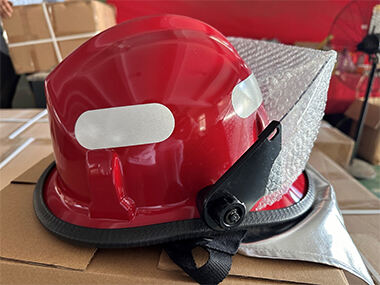Firefighter helmets are a vital part of firefighters' protective equipment and play a key role in protecting the head from injury, especially at fire scenes and during rescue missions. With the continuous development of firefighting technology and equipment, modern firefighter helmets have been significantly improved in design and function, which can not only effectively resist high temperature and high pressure, but also improve the comfort and operational flexibility of firefighters. The following is the current status of the use of firefighter helmets and related instructions:
1. The main function of firefighter helmets
The main function of firefighter helmets is to protect firefighters' heads from high temperatures, splashing molten materials, and impacts of collapsed objects in fires. It can not only withstand direct contact with flames, but also protect the head from external physical damage when firefighters perform emergency rescue and firefighting operations.
2. Design and materials of modern firefighter helmets
Modern firefighter helmets are usually made of lightweight, high-strength materials, such as fiberglass or Kevlar, which have high impact resistance and can effectively insulate heat. In addition, the lining of the helmet is usually made of sweat-absorbent and breathable materials to improve comfort and reduce discomfort caused by long-term wear.
The appearance design of helmets is also becoming more and more ergonomic, and many helmets are equipped with adjustable lining systems to ensure that each firefighter can find the most suitable wearing position for themselves. At the same time, modern helmets are usually equipped with reinforced masks, ear guards and neck guards to further enhance the protection function.
3. Functional accessories of firefighter helmets
In addition to basic protection functions, modern firefighter helmets are usually equipped with some functional accessories:
Fireproof mask: The fireproof mask can effectively protect the face from flames or toxic gases.
Helmet light: Many firefighter helmets are equipped with helmet lights to provide additional lighting for firefighters at dim fire scenes.
Communication equipment: With the development of technology, some helmets have integrated communication equipment, and firefighters can keep in touch with other members through helmets to ensure the smoothness of teamwork.
Respirator interface: Some helmets have interfaces for connecting to respirators, which can facilitate firefighters to operate collaboratively when wearing respiratory protective devices.
4. The current status of firefighter helmets
At present, the current status of firefighter helmets varies in different countries and regions, but generally they are developing in the direction of high performance, comfort and versatility. In China, with the improvement of fire safety awareness, fire brigades in various places pay more and more attention to the modernization and standardization of firefighters' individual protective equipment. Many cities and fire units have begun to generally use fire helmets that meet international standards, such as helmets that we can provide EN443 standards.
In addition, due to the changing working environment of firefighters, firefighter helmets must not only provide protection in fires, but also be able to cope with a variety of complex and dangerous environments such as falling objects, electric shocks, and chemical leaks. Therefore, the versatility and adaptability of firefighter helmets have become an important trend in the design of modern firefighting equipment.
5. Maintenance and inspection of firefighter helmets
In order to ensure that the helmet can provide adequate protection at critical moments, regular inspection and maintenance are necessary. After a period of use, the firefighter helmet needs to be inspected to ensure that there is no damage, cracks or obvious wear on the surface of the helmet, and to check the integrity of the lining and helmet accessories. It is very necessary to conduct a comprehensive inspection and maintenance of the equipment every year.
6. Conclusion
Firefighter helmets are indispensable protective equipment for firefighters. With the development of technology and changes in demand, their design and functions will continue to be updated and upgraded. Keeping an eye on the performance of the helmet and regularly checking its usage status can better protect the lives of firefighters and improve their work efficiency. In the future, the design of firefighter helmets will also be more intelligent and personalized, providing more protection for firefighters.

 EN
EN
 AR
AR
 HI
HI
 JA
JA
 KO
KO
 NO
NO
 RU
RU
 CA
CA
 TL
TL
 IW
IW
 ID
ID
 SR
SR
 UK
UK
 VI
VI
 SQ
SQ
 GL
GL
 MT
MT
 TH
TH
 TR
TR
 FA
FA
 AF
AF
 MS
MS
 SW
SW
 CY
CY
 IS
IS
 MK
MK
 HY
HY
 AZ
AZ
 EU
EU
 KA
KA
 HT
HT
 UR
UR
 BN
BN
 LA
LA
 MN
MN
 NE
NE
 SO
SO
 MY
MY
 KK
KK
 UZ
UZ



